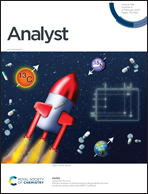Competitive electrochemical sensing for cancer cell evaluation based on thionine-interlinked signal probes
Abstract
The development of effective methods for tracking cancer cells is of significant importance in the early diagnosis and treatment of tumor diseases. Compared with the developed techniques, the electrochemical assay has shown considerable potential for monitoring glycan expression on the cell surface using nondestructive means. However, the application expansion of the electrochemical strategy is strongly impeded owing to its dependence on electroactive species. In this study, a competitive electrochemical strategy was reported for monitoring cancer cells based on mannose (a typical glycan) as a clinical biomarker. Herein, functionalized carbon nanotubes were used to load the thiomannosyl dimer, and thionine-interlinking signal probes were designed for competitive recognition. After effective competition between cancer cells and the anchored mannose, a decreased current was obtained as the cell concentration increased. Under optimal conditions, the proposed biosensor exhibited attractive performance for cancer cell analysis with a detection limit as low as 20 cells per mL for QGY-7701 and 35 cells per mL for QGY-7703, facilitating great promise for the sensitive detection of cancer cells and thus showing potential applications in cancer diagnosis.



 Please wait while we load your content...
Please wait while we load your content...